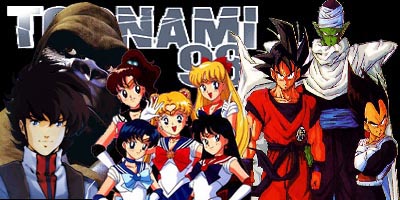 |
|||||
|
|
|
|
|
|
|
| Toonami 1998 |
 In 1997, Toonami debuted. In 1998, the block began to solidify finding a vision and premiering two shows that would be cornerstones of the block for years to come. In 1997, Toonami debuted. In 1998, the block began to solidify finding a vision and premiering two shows that would be cornerstones of the block for years to come.
Toonami was a very popular block to its loyal viewers, but Cartoon Network didn't know what to make of it. Afterall, it was a block that aired mostly 80s action-animation that only attracted a lot of older viewers. The first major premiere of 1998 was Robotech, Harmony Gold's creative splicing of three separate, unconnected mecha-oriented action-animation from Japan. The week of March 9 brought something of an oddity to the block. It wasn't an oddity because it wasn't an 80s action series nor something in the Turner library. It was an oddity because this was a significant event on Cartoon Network, let alone Toonami. Toonami presented the world premiere of the final five episodes of the 1997-98 season of Beast Wars: Transformers, a popular syndicated series at the time. These final five episodes aired in order weeks before they debuted in syndication. Apparently, Hasbro saw something in Toonami that perhaps Cartoon Network didn't see at first. March also was the first revamping period of Toonami. For starters, the block no longer aired three series with Roulette shorts inbetween the shows but rather a linear four-series block (Thundercats, Robotech, Voltron, and The Real Adventures of Jonny Quest). With the introduction of a new logo, Toonami began opening with individualized daily openings, a practice that ended in 2000. DC Comics' Cartoon Network Presents title brought the backstory of Toonami for the first time anywhere Every four months, CNP published a Toonami issue with Roulette quarterly publication of stories under the Toonami banner, with stories about the block's host Moltar and Clyde 49 at each break ala the Toonami block itself. Meanwhile, the internet generation began professing their love for the block. Toonami Online, Toonami CJB, Toonami: The Unofficial, and a site that's near and dear to my heart named CN2: Toonami Realm (which made its online debut on July 10, 1998) all made their debuts that summer. They were the first online areas dedicated to Toonami, which was surprising considering that Cartoon Network.com had made a much lauded relaunch earlier in the year with sections dedicated to all of their programming except for Toonami. It would take a moon princess to be the first Toonami show to make the front page of the website as well as forever change the direction of the block. Sailor Moon had a unique 1998. It began the year on the USA Network's Action Extreme Team. The series was limited to the 8 AM EST slot every weekday morning, but it was evident that with the cancellation of the USA Cartoon Express that USA wasn't interested in children's programming anymore. In April, Sailor Moon and all the other kid-vid series on USA were cancelled. Its cancellation left the popular series without a home for the first time since its premiere. Fortunately, Cartoon Network acquired the broadcast rights to series for the Toonami block, including the US debut of the rest of the Sailor Moon R season that was largely limited to Canada, where it still had a strong viewership base. The series premiered on June 1 and continued to be one of Cartoon Network's highest rated series throughout the year along with the acquisition of another high-profile series that premiered almost three months later. Dragon Ball Z also had a unique 1998. The series was virtually done in syndication. After two lackluster seasons in syndication and Saban, the series' original syndicator, giving up on the series after two seasons without even airing it on their Fox Kids block, FUNimation shopped the series around and ending up at Cartoon Network, where the series became a major cornerstone series on the block. Together, Sailor Moon and Dragon Ball Z became the new face of Toonami and a new vision of what to expect for years to come. In October, Toonami cancelled the Saturday edition of Toonami and the older Toonami properties Thundercats, Voltron, and Robotech. Another USA casualty, The Superman/Batman Adventures anthology series, premiered under the name Superfriends. Sailor Moon began airing the final 17 episodes of Sailor Moon R on November 30 while Dragon Ball Z was limited to repeat throughout the rest of the year. 1998 was the year that Toonami began to grow. As with all things in life, the block had some growing pains. Toonami made a few mistakes and learned from them. In the end, 1998 proved to be the year that people began to realize what Toonami is all about. |